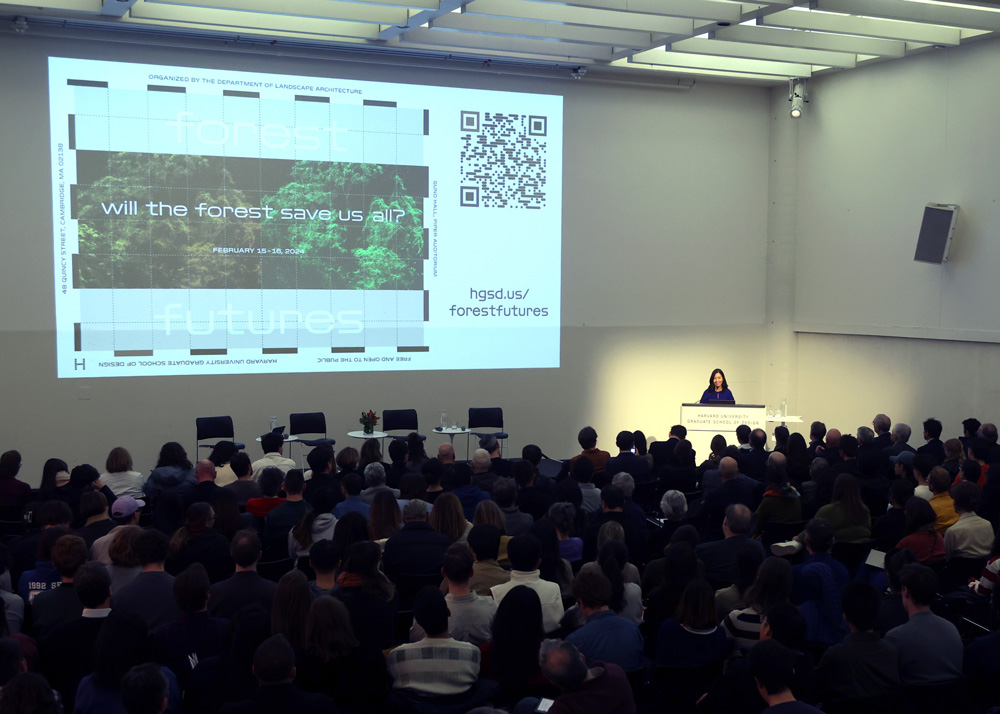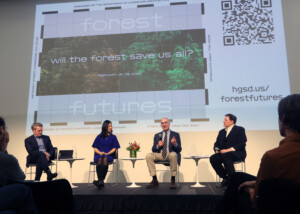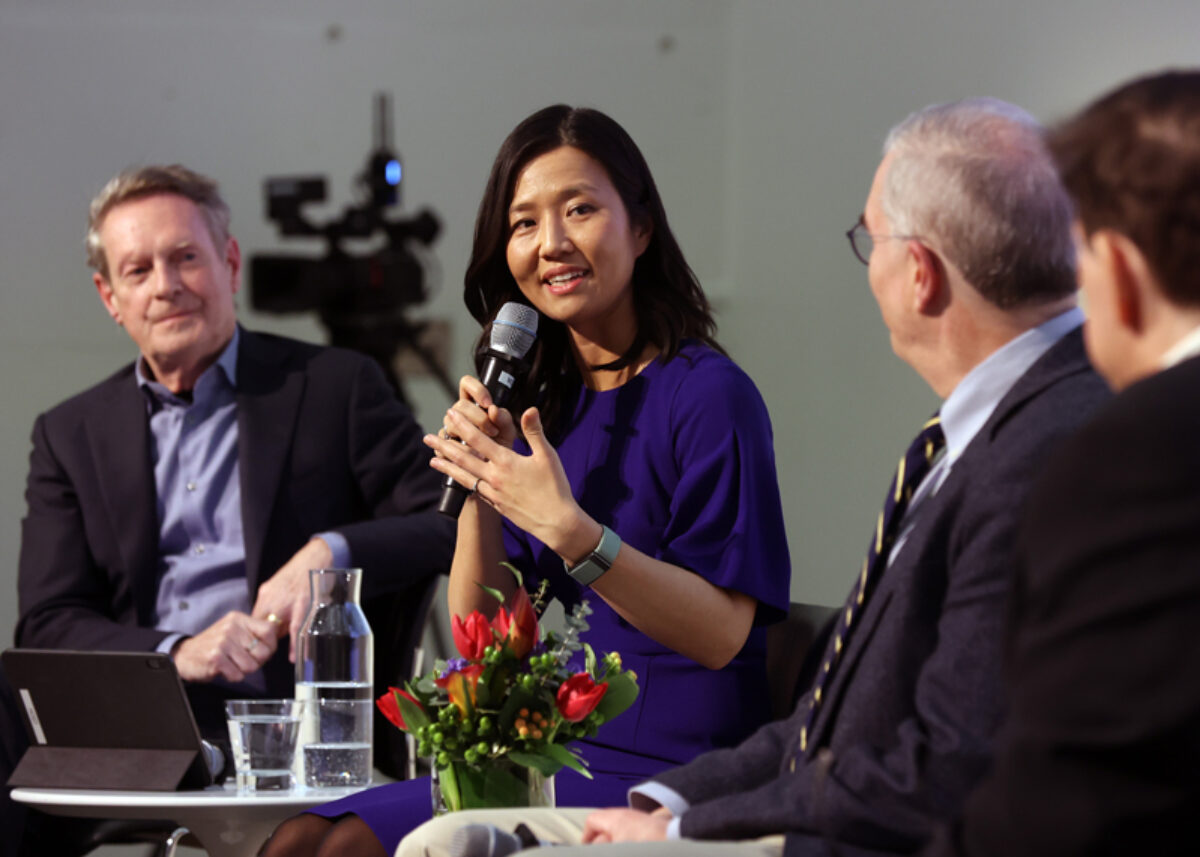Describing herself as an avowed “tree hugger” from her childhood as part of an immigrant family, when a beloved tree afforded her a sense of peace, Boston Mayor Michelle Wu offered a forceful vision for the role of urban forests in her city’s push for environmental justice and climate resiliency. In the packed Piper Auditorium at the Harvard Graduate School of Design, Mayor Wu spoke of sharing her lifelong affection for vegetation with her own children, and how a deeply felt connection with trees informs her work advocating equitable provisions of urban forests and parks.
According to Mayor Wu, forested public spaces are much more than a pleasant amenity or even essential resources for public health and environmental well-being. “Parks uniquely create an opportunity for all of us to be in connection with each other,” she said. In so doing, they foster democratic values at a time when democracy itself is under threat.
“The forest may be the last place where we are truly in community with everyone,” she said.
Mayor Wu was a keynote speaker on the opening evening of “Forest Futures: Will the Forest Save Us All?”, a two-day academic symposium at the GSD organized by Gary Hilderbrand, Peter Louis Hornbeck Professor in Practice of Landscape Architecture and Chair of the Department of Landscape Architecture, and Anita Berrizbeitia, Professor of Landscape Architecture. The symposium brought together designers, researchers, and expert practitioners from various fields to address “risks and threats, initiatives and improved practices, and speculations on a more secure and more just future for metropolitan and urban forests and the species that inhabit them.” (Video recordings of the full symposium are available online.)

Mayor Wu’s appearance coincided with the opening reception for the related exhibition, Forest Futures, on view in the Druker Design Gallery through March 31. Curated by Berrizbeitia, the exhibition features artworks, design projects, and research that explores how forests have become “designed environments.”
The themes of the conference and exhibition find expression in major policy initiatives, including Boston’s Urban Forest Plan, released in 2022. Created in part to redress the legacies of inequality and environmental injustice, the plan identifies strategies to engage Boston’s different communities to “prioritize, preserve, and grow our tree canopy.”
In January, the mayor signed a public tree protection ordinance, one of the plan’s recommendations. Explaining the importance of these measures after her public remarks, Mayor Wu linked efforts to ensure an equitable distribution of tree canopy to existing urban planning processes. “Every time a new building is built we think about the traffic impacts or the curb cuts,” she said, characterizing the Urban Forest Plan as “a recognition that trees are just as important a part of public infrastructure.” Dense tree canopies confer clear public health benefits, and greenspaces absorb runoff, mitigating floods.
The city’s related Franklin Park Action Plan was initiated to revitalize Boston’s 527-acre Frederick Law Olmsted-designed park, which has fallen into disrepair over the years. A self-described “devotee of Olmsted,” Mayor Wu sees Franklin Park, long overshadowed by the iconic landscape architect’s plan for Central Park in New York, as overdue for recognition as “the culmination of Olmsted’s vision and practices towards the later part of his career.”
Demonstrating deep familiarity with the park, Mayor Wu explained how Olmsted integrated his designs with the natural landscape, his work, “perfectly drawn on the natural features, the drumlins . . . the various boulders and vegetation that were already there.” The process to restore the park has been led by Reed Hilderbrand, the landscape architecture practice of which Gary Hilderbrand is a principal.
Olmsted (1822–1903) was an influential designer whose thoughts about the natural world and public space extended into a democratic vision he called “communitiveness.” As the city aims to restore his design for the park, the focus is on more than “the physical characteristics of how he laid out the park and its unique landscape,” Mayor Wu said. “This was supposed to be a place where people from every background could have respite from the needs and obligations of their day-to-day lives. This could be a place where people from all communities could come together and feel a connection. . . That is Franklin Park’s role in the city of Boston today.”
Mayor Wu shared the stage with keynote speaker William (Ned) Friedman, Director of the Arnold Arboretum of Harvard University and Arnold Professor of Organismic and Evolutionary Biology. Friedman described his “obsessions” with plants and the need to care for trees on their own terms as an act of recognizing their “standing” in our changing world. Edward Eigen, Senior Lecturer in the History of Landscape and Architecture and MDes Domain Head at the GSD, led a wide-ranging conversation after the talks.

The conversation covered the deep ties between the City of Boston and Arnold Arboretum. In a remarkable arrangement, Harvard gifted the land on which the Arboretum sits to Boston. In turn, the city agreed to lease it back for one thousand years, with the option to renew it for another millennium. (The rental price for 281 acres in the heart of Boston? $1 a year.) Pointing to this “sense of longevity,” the Mayor said, “trees help us understand the passage of time.”
After her public remarks, the mayor said that Arnold Arboretum had recently donated to the city 10 Dawn Redwoods, which will be distributed as part of the Urban Forest Plan in accordance with its community-driven values. The tree is the central image on the Arboretum’s emblem, a testament to the institution’s role in conserving what had been thought an extinct species. Now, the trees will also be a symbol of the Urban Forest Master Plan’s commitment to equity, as the redwoods find homes in Noyes Playground in East Boston, Harambee Park in Dorchester, and at a public housing complex in Mattapan.
